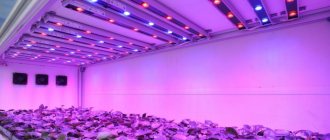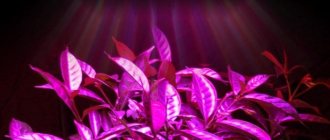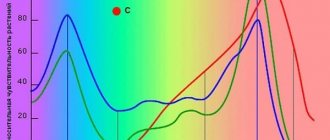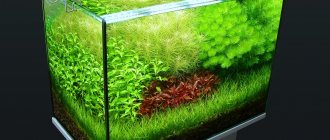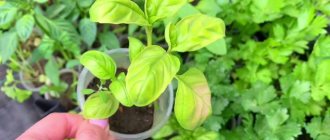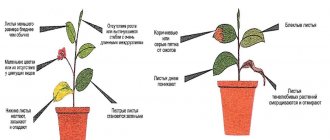Every experienced gardener knows the huge role that properly selected lighting for indoor plants plays. Along with watering and soil, light is an indispensable component on which successful growth directly depends. It is no secret that in the natural environment, some plants thrive in shaded areas, while others cannot develop without direct exposure to sunlight. At home, the situation looks similar. Let's talk in detail about how to properly make artificial lighting for indoor plants.
Decorative lighting and lighting for plant growth
A lamp for growing indoor plants is a great way to extend daylight hours. After all, many indoor flowers are of tropical origin, which means they experience a daily lack of solar energy, especially in winter. For effective plant growth, the daylight hours should be about 15 hours. Otherwise, they weaken, stop blooming and are susceptible to various diseases.
When planning the future illumination of indoor flowers, it is important not to miss the aesthetic component. The phytolight should become part of the interior, a unique decorative element. There are a huge number of lamps on sale with wall mounts of different shapes, suitable for any energy-saving lamp: CFL or LED. Depending on the size of the home flower garden, lighting can be made from several spot lights aimed directly at each green pet, or from tubular fluorescent lamps with a reflector. Using your own imagination, you can make an original LED phytolight yourself.
The most important component of growth is the light spectrum
In order to understand how inhomogeneous light is from different electrical sources and the sun, you need to look at their spectral composition. The spectral characteristic is the dependence of the radiation intensity on the wavelength. The solar radiation curve is continuous throughout the visible range with a decrease in the UV and IR regions. The spectrum of artificial light sources in most cases is represented by individual pulses of different amplitudes, which as a result gives the light a certain hue.
During the experiments, it was found that for successful development, plants do not use the full spectrum, but only its individual parts. The following wavelengths are considered the most vital:
- 640–660 nm – velvety red color, necessary for all adult plants for reproductive development, as well as for strengthening the root system;
- 595–610 nm – orange for flowering and fruit ripening;
- 440–445 nm – violet color for vegetative development;
- 380–400 nm – near UV range to regulate the rate of growth and formation of proteins;
- 280–315 nm – mid-UV range to increase frost resistance.
Lighting with only the listed rays is not suitable for all plants. Each representative of the flora is unique in its “wave” preferences. This means that it is impossible to fully replace the sun's energy using lamps. But artificial lighting of plants in the morning and evening hours can significantly improve their life.
Making a lamp for flowers with your own hands
You can make a phyto-lamp yourself at home. Such a device will cost much less than one purchased in a store. The easiest way to assemble an LED lamp is by selecting LEDs by power and color. To design the simplest model, you need to select elements with a power of 3 Watts in the following proportion:
- one green;
- one white;
- four blue with a light wavelength of 445 nm;
- ten red ones with a light wavelength of 660 nm.
Do-it-yourself phytolamp
LEDs are attached using thermal paste to an aluminum radiator plate. After mounting, they are soldered and connected in series with wires, after which they are connected to a driver that will match the current strength. And a fan is attached to the back of the radiator (you can use a fan from the computer system unit).
You may be interested in:
Do-it-yourself lighting for seedlings Not a single living organism is capable of existing without light. Plants, especially in the initial stages, need...Read more...
Signs of lack of light
There are a number of signs by which it is easy to identify a lack of light. You just need to take a close look at your flower and compare it with the standard. For example, find a similar view on the Internet. A clear lack of illumination manifests itself as follows. The plant slows down its growth. The new leaves are smaller and the stem becomes thinner. The lower leaves turn yellow. The flower either stops blooming completely, or the number of buds formed is less than the statistical average. It is assumed that watering, humidity and air temperature are normal.
How much light do you need?
It is impossible to give a definite answer to this question. Just as a person can live in different parts of the globe, so an indoor flower can grow on a windowsill facing north, south, west or east. Throughout its life, the plant will strive to adapt to current conditions: stretch upward due to lack of light or, conversely, expose the next blossoming bud to the sun’s rays.
By observing the appearance of the stems and leaves, the size and number of flowers, you can determine the adequacy of the lighting level. At the same time, do not forget about what stage of development the indoor flower is at: growing season, flowering, seed ripening. At each stage, it takes light from the sun of the wavelength that it needs at the moment. Therefore, when organizing additional lighting, it is important to take into account the qualitative component of the light flux.
Long-term exposure to bright light from the sun and lamps with an illumination level of more than 15 thousand lux is favored by those indoor flowers that grow in the open air in their natural habitat. These are many people's favorite crassula, geranium, kalanchoe, and begonia. Artificial lighting for plants of this type in the evening will benefit them.
Representatives of the flora that feel comfortable in illumination of 10–15 thousand lux include spathiphyllum, clivia, saintpaulia, tradescantia and dracaena. The leaves of these types of indoor flowers do not like hot sunlight, but also do not tolerate early twilight. Therefore, the ideal place for them would be a window sill with access to the west, where in the evening their leaves will receive the necessary energy from the setting sun.
So-called shade-loving plants can bloom and develop away from the window opening, being content with illumination of up to 10 thousand lux. However, this does not mean that they will die if they are placed in a brighter place. They just need less direct sunlight. These include some types of ficus and dracaena, philodendron, as well as tropical vines.
How to properly highlight seedlings
Choosing lamps is not enough. To achieve results, you need to follow a number of recommendations to ensure optimal conditions for the development and growth of plants.
Distance from lamp to surface
The location largely depends on the type of lamps; it is best to use LEDs as they are the most affordable and convenient. Select the height according to the recommendations:
- After sowing the seeds, it is better to place lamps at a height of 12 to 15 cm. High lighting intensity is important here so that the sprouts have enough light to grow through the soil.
- When the shoots appear, it is worth raising the lamp to a height of 15 to 20 cm. Select the exact distance according to the situation. It is important that the light is distributed evenly and covers the entire area of the soil.
- When further growing seedlings, maintain a distance of 20 to 25 cm. Remember that the plants grow taller, so you need to check the position and change it at least once a week.
It is easiest to use these tips when determining the height of the lamps.
By the way! The distance is measured from the lamp to the top of the seedling.
For how long should the lamps be turned on?
There is culture and several other aspects to consider. It won't be too difficult to figure it out:
- For tomatoes and other heat-loving plants, lighting must be provided for 15-17 hours.
- Other crops require less time, usually 11-13 hours is enough.
- It is best to check the optimal indicators on the seed package. You can find information online on specialized resources.
- Based on the length of daylight hours to calculate how long the lamps should work. If the weather is cloudy outside, increase the illumination time for maximum effect.
- It is better to turn on the lamp in the morning and evening; it is much more effective than turning it on once a day.
The operating time of the lamps must be calculated based on the length of daylight hours.
If the plants are in a poorly lit room or are in a special box, then the lamps should work for the prescribed time.
Supplementary lighting for plants and artificial lighting sources
In most cases, indoor plants need additional lighting. Flowers, which at first glance have bright green succulent leaves and bloom regularly, will look even better if they are exposed to a phytolamp. If someone thinks otherwise, then he has an excellent chance to be convinced of the error of his thinking and assemble a phyto-lamp with his own hands. To extend daylight hours, various sources of artificial light are used. Let's look at each of them and figure out which light is best for plants.
Incandescent lamps
Illuminating plants with incandescent lamps is the least effective for several reasons. The emission spectrum of conventional light bulbs with a spiral is strongly red-shifted, which does not contribute to photosynthesis in any way. Low efficiency and, as a consequence, enormous heat generation drive their energy and light efficiency to zero. In addition, incandescent lamps have the shortest service life compared to other artificial light sources.
Fluorescent lamps
Tubular fluorescent or, as they are most often called, energy-saving fluorescent lamps of the T8 full spectrum type (T = 5300–6500°K) are considered the best option for illuminating indoor plants for many years.
They have earned many positive reviews due to the presence of a selective spectrum, efficiency and low heat transfer combined with reasonable cost. Companies specializing in the production of fluorescent lamps offer plant growers an improved option - a phytolamp with a selective emission spectrum. They work predominantly in the blue and red range, as can be seen from the characteristic glow. But the cost of such lamps for illuminating plants is an order of magnitude higher than their conventional counterparts.
DNAT
A sodium lamp is the most efficient light source. In terms of luminous efficiency and working life, these lamps are comparable to LEDs for plants. But they are not suitable for home use due to their excessively high brightness (more than 15 thousand lux). But in many greenhouses and conservatories, growing plants under artificial lighting is based precisely on gas-discharge lamps. Due to the fact that they emit more red light, they are installed in combination with 6500K fluorescent lamps.
LED light sources
All LED phytolights are divided into three groups:
- bicolor;
- with multispectrum;
- with full spectrum.
Bicolor or two-color lamps are based on blue (440–450 nm) and red (640–660 nm) LEDs. Their light is considered to be the most optimal for organizing illumination of any plants during the growing season. This working spectrum favors the process of photosynthesis, which leads to accelerated growth of green mass. That is why summer residents prefer blue-red LED lamps when growing vegetable seedlings on the windowsill.
LED lamps with a multispectrum have a wider application due to the expansion of the red range into the region of infrared and yellow light. They are in demand for illuminating adult plants, stimulating flowering and fruit ripening. In apartment conditions, it is better to use LED multispectrum for flowers with a dense crown.
A phytolight with a full spectrum of radiation can be used to illuminate flowers in an apartment, regardless of the type and location. This is a kind of universal artificial light source that emits over a wide range with maximums in the red and blue zones. The full spectrum LED lamp is a tandem of energy efficiency and light energy reminiscent of the action of sunlight.
Today, the creation of favorable conditions for a widespread transition to phyto-LEDs is not happening for two reasons:
- high cost of high-quality lamps for plants;
- a large number of fakes based on conventional LEDs.
Recommendations for installing luminaires with phytolamps
Orchid lighting
When installing the lamp, follow a few simple rules so as not to harm the plants.
- For the most efficient use of light flux, you can use mirror screens. In addition to being beneficial to plants, they protect people's eyes from blue and red light.
- The light should be directed from top to bottom, just as the sun shines in nature.
- The lamp is placed at a minimum height to prevent light burns.
- The lamp should not be exposed to drops of water.
What light is best for growth?
Of course, the ideal light source is solar energy. In apartments with windows facing southeast and southwest, you can grow any flowers, placing them in different parts of the room. But don’t be upset for those who only have a north-facing view from their window. Fluorescent and LED lamps for lighting plants compensate for the lack of sun rays.
Fluorescent lamps for plants are a time-tested budget option. They are suitable for those who are trying to create normal conditions for a flower with little investment. LED phytolamps are for those who want to speed things up and achieve the best results in a short time, despite the price of several thousand rubles.
Sodium
They are one of the best lamps for plants. They are characterized by high luminous efficiency, economy and operational efficiency. They emit orange and red rays; use in combination with blue radiation makes it possible to optimize the process of growth and bud formation.
The disadvantages include high prices for sodium lamps and their large sizes. Considering the above, they are good to use in a winter garden - a 220 W ceiling lamp can illuminate a fairly large space.
Another small disadvantage is that such lamps require special disposal, since they contain mercury, xenon and sodium inside.

